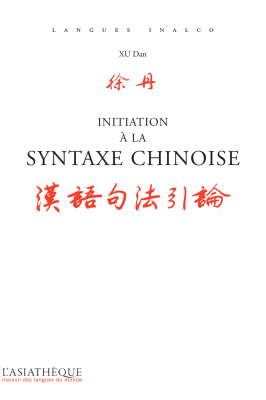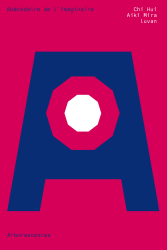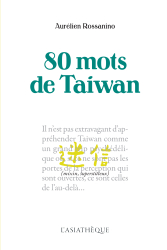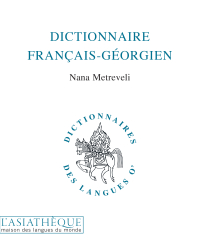Details
Format: Paperback
ISBN: 9782360570058
Collection: Langues INALCO
16 x 24 cm
Weight: 393 gr
Pages: 224
First publication: 12/11/1996
Last printing: 10/2010
Initiation à la syntaxe chinoise
Des repères et des analyses pour écrire et parler juste
Preface : Claude Hagège
This new and up-to-date revised edition of "Introduction to Chinese Syntax" is intended for both students of the Chinese language, since it provides answers to their common questions, as well as for specialists in Chinese linguistics, as the study of this language also benefits from the latest developments in research. The author satisfies the demands for both audiences with great success.
The book's seven chapters each consist of sections which are presented as a question, followed by a discussion of the solution. Xu Dan presents 80 problems of increasing difficulty. Each section ends with a summary to facilitate comprehension. The topics are representative of common problems encountered by learners of Chinese. Diachronic approach and comparative studies (Mandarin and other Chinese dialects) of the principal problems concerning Chinese syntax.
XU Dan, is a University professor at the National Institute of Oriental languages and civilisations (Inalco). She is also a senior member of the university institute of France (IUF).
CONTRIBUTORS' BIOGRAPHIES
Xu Dan

XU Dan is Professor of Chinese Language and Linguistics at INALCO and Senior Fellow of the Institut universitaire de France. She is the co-author of Les Résultatifs du chinois contemporain, dictionnaire pratique, published at L'Asiathèque.
Claude Hagège
Claude Hagège (born in 1936) is a French linguist of Tunisian origin. Polyglot, he has knowledge of around fifty languages, including Italian, English, Arabic, Mandarin, Hebrew, Russian, Hungarian, Turkish, Persian, Malay, Hindi, Malagasy, Fulani and Japanese. Agrégé of classical letters, he taught at the Lycée de Carthage from 1959 to 1961. Director of studies in structural linguistics at the Practical School of Higher Studies in 1977, he held the chair of linguistic theory at the Collège de France, between 1988 and 2006. He is currently honorary professor at the Collège de France.
TABLE OF CONTENTS
Préface à la première édition (Preface to the First Edition)
Préface à la deuxième édition (Preface to the Second Edition)
Abréviations (Abbreviations)
Chapitre I (Chapter 1)
Introduction: l'évolution syntaxique du chinois et ses conséquences (introduction: The syntactic evolution of Chinese and its consequences)
1.0. Généralités (1.0. General points)
1.0. Évolution diachronique et dialectes contemporains (1.1. Diachronic change and modern dialects)
1.2. Quel est l'ordre des mots en chinois ? (1.1. What is the word order in Chinese)
1.3. Quelle est l'évolution syntaxique la plus remarquable? (1.3. What is the most significant syntactic change?)
1.4. Pourquoi chī peut-il signifier « avoir mangé » ou « être mangé » ? (1.4. Why is it that chīcan mean both "to eat" and "to be eaten"?)
1.5. Quelles sont les conséquences de l'évolution syntaxique en chinois ? (1.5. What are the consequences of syntactic change in Chinese)
Chapitre II (Chapter 2)
Problèmes relatifs aux aspects (Problems related to aspect)
2.0. Introduction
2.1. Sur le (2.1. On le)
2.1.1. Quel est le rôle aspectuel de le ? (2.1.1. What is the aspect role of le?)
2.1.2. Quand le est-il obligatoire ? (2.1.2 When is le obligatory?)
2.1.3. Quand l'emploi de le est-il agrammatical ? (2.1.3 When is the use of le ungrammatical?)
2.1.4. Comment employer le quand la phrase contient plus d'un verbe ? (2.1.4 How is le used when the sentence has more than one verb?)
2.1.5. Quel est le statut de le 2 ?(2.1.5 What is the status of le 2 ?)
2.1.6. Quelle est la différence entre le 1 et le 2 ? (2.1.6 What is the difference between le1 and le2?)
2.1.7. Comment employer la structure où il y a la cooccurrence de le 1 et de le 2 ? (2.1.7 How to use the structure with both le1 and le2)
2.1.8. Quelle est l'origine de le ? (2.1.8 What is the origin of le?)
2.2. Sur zhe (2.2. On zhe)
2.2.1. Quels sont les verbes qui sont marqués par zhe ? (2.2.1. What verbs are marked by zhe)
2.2.2. Quels sont les emplois figés de zhe ? (2.2.2. What are the fixed uses of zhe?)
2.2.3. Comment employer V1 zhe O V2 ? (2.2.3. How is V1 zhe V2 used?)
2.2.4. Quelles sont les deux fonctions grammaticales élémentaires de zhe ? (2.2.4. What are the two basic grammatical functions of zhe ?)
2.2.5. Quelle est la différence entre zhe et le en mandarin ? (2.2.5. What is the difference between zhe et le in mandarin?)
2.2.6. Quelle est l'évolution de zhe ? (2.2.6. How did zhe evolve ?)
2.3. Sur guo (2.3. On guo)
2.3.1. Quel est le statut particulier de guo ? (2.3.1. What is the particular status of guo ?)
2.3.2. Quelle est la différence entre guo P.A. et guo V Rés. ? (2.3.2. What is the difference between aspect particle guo P.A. and resultative guo ?)
2.3.3. Comment employer la séquence V guo le ? (2.3.3. How is the sequence V guo le used?)
2.3.4. Quelle est l'évolution de guo ? (2.3.4. How did guo develop?)
2.4. Le marquage aspectuel dans les dialectes (2.4.Aspect marking in the dialects)
2.4.1. Quelles sont les différences entre le Nord et le Sud ? (What are the differences between the North and South?)
2.4.2. Existe-t-il le 1 et le 2 dans d'autres dialectes ? (2.4.2. Do le 1 et le 2 exist in other dialects?)
2.4.3. Pourquoi le et zhe ne se distinguent-ils pas dans beaucoup de dialectes ? (2.4.3. Why are le and zhe not distinguished in many dialects?)
2.4.4. Est-ce que guo existe dans d'autres dialectes ? (2.4.4. Does guo exist in other dialects?)
Chapitre III (Chapter 3 )
Problèmes relatifs aux temps (Problems related to tense)
3.0. Introduction
3.1. Comment exprime-t-on les temps en chinois ? (3.1. How is tense expressed in Chinese?)
3.2.. Quels sont les synonymes qui sont liés aux temps ? (3.2. What are the synonyms which are related to tense?)
3.2.1. Cái/gāng et gāngcái
3.2.2. Chángcháng et wăngwăng
3.2.3. Dàodǐ et zhōngyú
3.2.4. Hòulái et yǐbòu
3.2.5. Jǐnguǎn et jíshǐ
3.2.6. Wèile et yǐbiàn
3.2.7. Yìzhí et shǐzhōng
3.1.8. Yòu et zài
3.3. Pourquoi qián peut-il indiquer aussi bien le passé que le futur ? (3.3. Why can qián indicate both past and future?)
3.3.1. Quels sont les comportements syntaxiques de qián/hòu ? (3.3.1. What are the syntactic behaviors of qián/hòu ?)
3.3.2. Pourquoi qián et hòu ne sont-il pas toujours symétriques ? (3.3.2. Why are qián and hòu not alway symmetrical ?)
Chapitre IV (Chapter 4)
La construction en de (The de construction)
4.0. Introduction
4.1. Comment peut-on distinguer de résultatif de de potentiel ? (4.1. How can we distinguish resultative de from potential de?)
4.2. Quelle est la différence entre hĕn kuài de V et V de hĕn kuài ? (4.2. What is the difference between hěn kuài de V and V de hěn kuài?)
4.3. Qu'est-ce que le de de degré ? (4.3. What is degree de?)
4.4. Quelles sont les caractéristiques de la construction en de quand il y a négation ? (4.4. What are the characteristics of the de construction with negation?)
4.5. Pourquoi V de et V bu de ne sont-ils pas parallèles ? (4.5. Why are V de and V bu de not parallel?)
4.6. Pourquoi de peut-il exprimer en même temps [+ accompli] et [- accompli] dans V de C (complément) ? (4.6. Why can de express both [+ PERFECTIVE] and [-‐ PERFECTIVE] in V de C?)
4.7. Quelles réflexions peut-on faire sur la construction en de ? (4.7. How can we further reflect on the de construction?)
Chapitre V (Chapter 5)
La construction en bă (The bă construction)
Introduction
5.1. Quand doit-on employer la construction en bă ? (5.1. When should bă construction be used?)
5.1.1. Bă + OD + V [+ donner]+OI (5.1.1. Bă + DO (direct object) + [+ GIVE]+ IO (indirect object))
5.1.2. Bă + O + V + zài + Loc. (5.1.2. Bă + O + V + zài + Loc.)
5.1.3. Bă + 0 + V + Cl. verbal (5.1.3. Bă + 0 + V + verbal Cl. (classifier))
5.1.4. Bă + O1 + V + O2 (5.1.4. Bă + O1 + V + O2)
5.1.5. Bă + O1 + V [+ causatif] + O2 (5.1.5. Bă + O1 + [+ CAUSATIVE] V + O2)
5.1.6. Bă + O + V + de + C de résultat (5.1.6. Bă + O + V + de + Resultative complement)
5.1.7. Bă + O1 [+ ensemble] + V + O2 [+ partie] (5.1.7. Bă + [+ WHOLE] O1+ V + O2 [+ part])
5.2. Quels sont les traits sémantico-syntaxiques du GN marqué par bă ? (5.2. What are the semantic syntactic features of the NP marked by bǎ?)
5.3. Quelles sont les propriétés du GV ? (5.3 What are the properties of the VP?)
5.4. Quel est le rôle syntaxique et sémantique de bă ? (5.4. What is the syntactic and semantic role of bă?)
5.5. Quelle est l'origine de la construction en bă ? (5.5. What is the origin of the bă construction?)
5.6. Quelle est la signification de la construction en bă ? (5.6. What is the meaning of the bă construction)
Chapitre VI (Chapter 6)
La construction passive (The passive construction)
6.0. Introduction
6.1. La construction en bèi (6.1. The bèi construction)
6.1.1. Quand doit-on employer la construction en bèi (6.1.1. When should the bèi construction be used?)
6.1.2. Quelles sont les contraintes syntaxiques dans la construction en bèi (6.1.2. What are the syntactic constraints on the bèi construction)
6.1.3. Quelles sont les propriétés sémantiques de la construction en bèi (6.1.3. What are the semantic properties of the bèi construction)
6.1.4. Comparaison entre bèi+ V et V [+subir] + V (6.1.4. Comparison between bèi+ V et [+UNDERGO]V + V)
6.1.5. Construction en bèi et construction en bă (6.1.5. The bèi construction and the bă construction)
6.2. Structures passives avec les verbes causatifs (6.2. Passive structures with causative verbs)
6.2.1. Ràng
6.2.3. Gĕi
6.3. Structures passives avec sujets-patients (6.3. Passive structures with subject-‐patients)
6.4. La construction passive en dialectes (6.4. The passive construction in dialects)
6.5. La construction passive en diachronie (6.5. The passive construction across diachronic periods)
Chapitre VII (Chapter 7)
Les verbes auxiliaires (Auxiliary verbs)
7.0. Introduction
7.1. Pourquoi certains verbes auxiliaires peuvent-ils avoir plusieurs sens ? (7.1. Why can some auxiliary verbs have several meanings?)
7.2. Quels sont les principaux verbes auxiliaires ? (7.2. What are the principal auxiliary verbs ?)
7.2.1. Néng et kĕyǐ
7.2.2. Néng et huì
7.2.3. Yīnggāi, gāi et dĕi
7.2.4. Yào et xiăng
7.3. La dissymétrie entre les formes affirmatives et négative (7.3. Dissymmetry between affirmative and negative forms)
7.4. Verbes auxiliaires diachroniques (7.4. Diachronic auxiliary verbs)
Postface de Claude Hagège (Postface by Claude Hagège)
Travaux cités (Works Cited)
Index














